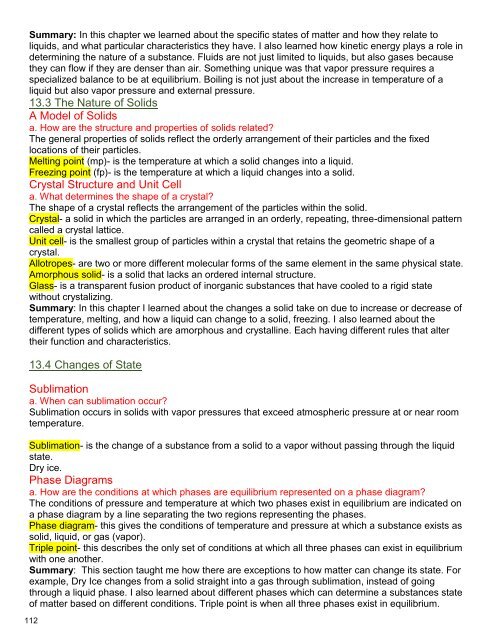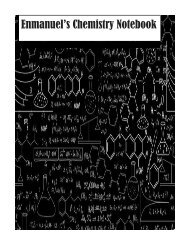Create successful ePaper yourself
Turn your PDF publications into a flip-book with our unique Google optimized e-Paper software.
Summary: In this chapter we learned about the specific states of matter and how they relate to<br />
liquids, and what particular characteristics they have. I also learned how kinetic energy plays a role in<br />
determining the nature of a substance. Fluids are not just limited to liquids, but also gases because<br />
they can flow if they are denser than air. Something unique was that vapor pressure requires a<br />
specialized balance to be at equilibrium. Boiling is not just about the increase in temperature of a<br />
liquid but also vapor pressure and external pressure.<br />
13.3 The Nature of Solids<br />
A Model of Solids<br />
a. How are the structure and properties of solids related?<br />
The general properties of solids reflect the orderly arrangement of their particles and the fixed<br />
locations of their particles.<br />
Melting point (mp)- is the temperature at which a solid changes into a liquid.<br />
Freezing point (fp)- is the temperature at which a liquid changes into a solid.<br />
Crystal Structure and Unit Cell<br />
a. What determines the shape of a crystal?<br />
The shape of a crystal reflects the arrangement of the particles within the solid.<br />
Crystal- a solid in which the particles are arranged in an orderly, repeating, three-dimensional pattern<br />
called a crystal lattice.<br />
Unit cell- is the smallest group of particles within a crystal that retains the geometric shape of a<br />
crystal.<br />
Allotropes- are two or more different molecular forms of the same element in the same physical state.<br />
Amorphous solid- is a solid that lacks an ordered internal structure.<br />
Glass- is a transparent fusion product of inorganic substances that have cooled to a rigid state<br />
without crystalizing.<br />
Summary: In this chapter I learned about the changes a solid take on due to increase or decrease of<br />
temperature, melting, and how a liquid can change to a solid, freezing. I also learned about the<br />
different types of solids which are amorphous and crystalline. Each having different rules that alter<br />
their function and characteristics.<br />
13.4 Changes of State<br />
Sublimation<br />
a. When can sublimation occur?<br />
Sublimation occurs in solids with vapor pressures that exceed atmospheric pressure at or near room<br />
temperature.<br />
Sublimation- is the change of a substance from a solid to a vapor without passing through the liquid<br />
state.<br />
Dry ice.<br />
Phase Diagrams<br />
a. How are the conditions at which phases are equilibrium represented on a phase diagram?<br />
The conditions of pressure and temperature at which two phases exist in equilibrium are indicated on<br />
a phase diagram by a line separating the two regions representing the phases.<br />
Phase diagram- this gives the conditions of temperature and pressure at which a substance exists as<br />
solid, liquid, or gas (vapor).<br />
Triple point- this describes the only set of conditions at which all three phases can exist in equilibrium<br />
with one another.<br />
Summary: This section taught me how there are exceptions to how matter can change its state. For<br />
example, Dry Ice changes from a solid straight into a gas through sublimation, instead of going<br />
through a liquid phase. I also learned about different phases which can determine a substances state<br />
of matter based on different conditions. Triple point is when all three phases exist in equilibrium.




